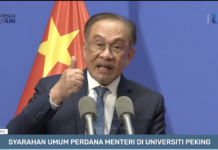By Siti Radziah Hamzah
BEIJING, June 9 – China is the world’s largest greenhouse emitter, but it has quietly transformed itself as a renewable energy powerhouse.
Over the years, the country became the location of investment in solar, wind and nuclear power. A move that Malaysia could emulate and implement faster to achieve its commitment on net zero carbon emission by 2050.
On this writer’s recent trip to the southeastern Chinese province — Fujian — it was learned that this area boasts around 4,500 wind turbines in the area including offshore, generating at least 30 per cent of electricity for China.
Under the purview of Fujian Three Gorges Maritime Wind Power Industrial Park, which owns 30 per cent of the 4,500 wind turbines, being the biggest share of wind turbines in the province, the wind turbines produce 1,434.57 megawatt of electricity per hour at its peak.
Fujian Three Gorges Offshore Wind Power International Industrial Park is the first full-industry-chain offshore wind power industrial park in China.
In November 2023, the world’s largest 18-megawatt direct-drive offshore wind turbine was unveiled at the Fujian Three Gorges Maritime Wind Power Industrial Park
These wind turbines in the industrial park also prove China’s dominance in the wind power industry globally, and the products of the industrial park are not only widely used in China’s offshore wind power development, catering not only for the domestic market but are also exported to countries including Turkey, the United Kingdom and Vietnam.
Moody’s Ratings noted that one of the key reasons for China’s dominance is because the wind power sector is a key part of the government’s decarbonisation plan.
As at end-2023, China has 441 gigawatt (GW) of installed wind capacity for both onshore and offshore wind, representing the highest global share of 43.4 per cent and its annual wind capacity addition of 76GW in 2023 also accounted for 65.5 per cent of the world’s total annual capacity addition.
China’s offshore wind farms are close to the eastern coastal load centre, where the offshore wind conditions are generally better than those on land.
In particular, Fujian Province is located on the west coast of the Taiwan Strait. In this area, affected by the “narrow tube effect”, the annual average wind speed at sea can reach about nine metres per second, and the offshore wind resources are at the forefront of the country.
Chinese wind turbine manufacturers also account for about half of the global wind turbines produced in 2022 and 2023.
“Other than being a clean energy source, wind power in China is also very cost competitive compared to fossil fuels. We expect wind power’s contribution to the nation’s power generation mix (standing at 10 per cent in 2023) to increase,” Moody’s Ratings told Bernama.
To date, China has estimated between 40 and 50 wind power plants in the country, including in Fujian.
China was the world’s largest contributor of new renewable capacity between 2012 and 2021. New projects for onshore wind and solar power in the country entered grid parity in 2022, and subsidies are no longer the major driver for the development of renewable energy.
In its research note in May 2023, Moody’s Ratings noted that increasing clean energy in China’s power mix is the key to the power sector’s carbon transition.
Compared to other clean energies, renewables are the most cost competitive energy in China based on current technology due to several factors namely more available renewable resources. less safety issues and new renewable projects have reached grid parity. – BERNAMA
















